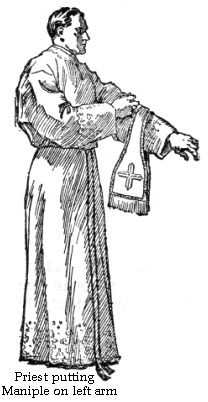While it is no longer the practice for all priests to offer prayers while vesting for Mass, many do offer these "vesting prayers." The prayers are a good occasion for them to be enriched with a profound humility and willing availability to act in the very Person of Christ at the Holy Sacrifice. In this series, we look at each vesting prayer and its corresponding vestment, as an intimate insight into the spiritual lives of priests at their most vulnerable moment every day, helping all the rest of us also to understand just who we are before God and neighbor.
PRAYER 5 – "Ad manipulum" (Prayer used for the maniple)
"Merear, Domine, portare manipulum fletus et doloris; ut cum exsultatione recipiam mercedem laboris." ("May I be made meritorious, O Lord, to bear a maniple of weeping and sorrow, so that I might receive with exaltation labor's reward.")
St. Alphonsus got it right in opining that priests offering Mass are at least spiritually weeping in this "leitúrgia," this liturgy, this "labor of the people." So intense, so anguished is the work, it is said by commentators, that the priest carried a towel on his left arm to wipe away his tears and sweat.
Such spiritualized observations are appropriate, but we need these to be grounded in the reality of the deadly battle on the altar, on Golgotha, which is presented with the Holy Sacrifice of the Mass. We can all think of examples in which symbols become stylized and transformed over the years. For instance, the Battlefield Cross appropriately symbolizes how a soldier made the supreme sacrifice, laying down his life for his friends. His bayoneted rifle is rammed into the ground behind his boots and is topped with his helmet. The same thing happened with the maniple.
A manipulus is a Roman military division directed by a centurion. Part of this field commander's gear was a cape, which, as we see with the stone funerary monuments of the day, was almost invariably depicted as being draped over the left arm to make sure no one would miss seeing this important sign of his authority over the manipulus. That cape was called a paludamentum (today's pallium worn by archbishops as, literally, a manifest sign of their authority). It was worn especially at the moment when armies were mustered to go into battle. Centurions, mind you, did not direct their soldiers from behind, but rather led them, becoming the commanders who most often died in battle, the first to lay down their lives.
By the time Augustus Caesar died in 14 A.D., the cape's use was restricted to the emperor alone, which only emphasized its aggressive symbolism of entering into battle. Augustus of Prima Porta, the most famous statue of the emperor, depicts the paludamentum actually being tied on to his left arm as the maniple of the priest is tied to his left arm. Even though Augustus reserved this symbol to himself, the history of the centurion's authority over a manipulus could not be erased from popular imagination.
It was easy for Jesus' followers in the early centuries, in having seen their Lord and God killed by Roman soldiers but then risen from dead, to know that the real battle, the epic war, is now taking place at the Last Supper united with the Cross. It would have been hard for them to resist making an incisive statement about this by way of having priests, the centurions of God, declare war, mustering their troops with the weapons of truth and charity, leading them with the authority of Jesus right to the Cross at Mass, where the One who is alone our High Priest, lays down His life, and our lives with His.
Is the weeping and sorrow of a field commander who almost certainly goes to his death for himself? No. It is for those in his charge, for their families. But for the priest who leads his congregation to the battle on the altar, carrying them to the Warrior, to Jesus, at the moment He is laying down His life for us, that weeping is not for them. They are blessed to be shining witnesses of God's goodness and kindness. Instead, this weeping refers to our knowing that it is by our sins that the Son of God laid down His life for us. It is also a weeping of humble thanksgiving. How could we not weep and be sorrowful for having offended Jesus with our sins? Yet, it is in this active friendship with Jesus that we exalt in our salvation, the reward of our labor.
For the priest, that labor comes with bearing the weight of the entire manipulus in one's charge: the congregation, the parish family of faith. The priest, the father of the local family of faith, is privileged to bring them to Jesus, and this is a joy. Yet, the weight of that responsibility can crush the priest just as Jesus was crushed in His agony in the Garden. But more than this, the priest knows he is entirely unworthy to have such authority or to bear such weight. The point of the prayer, of course, is that the priest asks God to be made worthy, but not by any action on the priest's part.
The prayer for this vestment, the maniple, is a most appropriate way to prepare for going into battle with Jesus – the Holy Sacrifice of the Mass. Even if today many of us priests do not have this vestment in our sacristies, we can still offer this prayer with the spiritual maniple we posses by way of ordination. We are always called in this "ecclesia militans," this Church Militant, to lead our parish families of faith to Jesus at the moment He manifests to us His greatest goodness and kindness.
Father George David Byers is administrator of Holy Redeemer Parish in Andrews.




